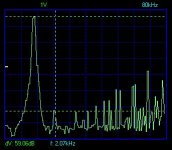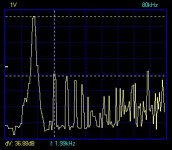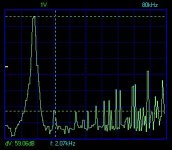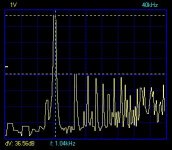Nice plot Pedja! How do you make these plots?
Peter: the 'truth' can hurt sometimes
I agree that 5V sometimes sounds more pleasant with bad recordings. But IMHO its sucks all the life and dynamics out of the music. But it is also a matter of balance of the set. If I put the + input of my gainclone directly to earth, the sound is too harsh for my taste. So, maybe that's the difference between our audio sets...
Fedde
Peter: the 'truth' can hurt sometimes
I agree that 5V sometimes sounds more pleasant with bad recordings. But IMHO its sucks all the life and dynamics out of the music. But it is also a matter of balance of the set. If I put the + input of my gainclone directly to earth, the sound is too harsh for my taste. So, maybe that's the difference between our audio sets...
Fedde










I think the J309 that Pierre-Frédéric Caillaud (peufeu) is using is a further development of one of my previous circuits, where a jfet is used as cascode element, and an opamp (LM6172) driving the gate to keep dac output at voltage compliance.
Later I replaced the J309 with a BS170 because of higher transconductance.
Even later I replaced the BS170 with a bjt and after just removed the feedback loop by removing the opamp.
It's somewhere in these archives.
He mentioned indeed that he cascoded the jfet with good result.
BTW anybody has some 1.5K Rikens for me to try as Riv ?
I've always used generic magnetic resistors so far, just want to hear if it makes enough improvement to really care.
Thanks,










The best ones could be stamped with a CROWN and sold to the inmates for a nice price (covering your expenses of course).
The fact that we're living in a monarchy having a queen could be the reason for your obsession with crowns
I'll be glad to mark them with a crown if that makes you feel better
Hi Fedde,
It was SpectraLab, demo was available for download, but I heard now Sound Technology offers only low resolution version for trial.
Check also this link.
Pedja
It was SpectraLab, demo was available for download, but I heard now Sound Technology offers only low resolution version for trial.
Check also this link.
Pedja
So you just use your sound card to make it ? Do you have a high quality ADC ? I would really like to have a good measurement system like that! I have also a very good measurement microphone (totally flat), but I am afraid that my SB live ADC will not be sufficiently good to use it. (especially >10 kHz)
Fedde
Fedde
Fedde,
As long as you do not need sampling frequency higher than 48kHz, Live! will be just fine. And it was exactly what was used for the measurement above. Its amplitude response is not flat entirely, but is surely flatter than any (even flattest) mike. Again, if you talk about speaker measurement, you can apply some compensation in most of the speaker measurement programs.
Anyway, Live!’s (used at recommended 48kHz sampling freq) performance can be seen
here.
Pedja
As long as you do not need sampling frequency higher than 48kHz, Live! will be just fine. And it was exactly what was used for the measurement above. Its amplitude response is not flat entirely, but is surely flatter than any (even flattest) mike. Again, if you talk about speaker measurement, you can apply some compensation in most of the speaker measurement programs.
Anyway, Live!’s (used at recommended 48kHz sampling freq) performance can be seen
here.
Pedja
on request my measurement.....
The d2 is -59dB the d3 is not present. Just ignore all the HF rubbish, some of it is coming from my not so expensive digi scope... When you play with the DC adjustments, you see the d2 and d3 go up and down like a jojo, the other stuff stays almost the same, so no/little correlation with the audio
Will post at the next one a FFT from a sine wave with DC = 3,5Volt.... just watch
By the way, if some one likes the sound with single dacs better, fine, it does sound different and could be appealing more to others, I think both are nice and good and personal taste does a lot. I like Remy Martin XO, Others Dimpel Wiskey. I only use Wiskey to clean the window Does this make Cognac better? Don't think so....
Does this make Cognac better? Don't think so....
doede
The d2 is -59dB the d3 is not present. Just ignore all the HF rubbish, some of it is coming from my not so expensive digi scope... When you play with the DC adjustments, you see the d2 and d3 go up and down like a jojo, the other stuff stays almost the same, so no/little correlation with the audio
Will post at the next one a FFT from a sine wave with DC = 3,5Volt.... just watch
By the way, if some one likes the sound with single dacs better, fine, it does sound different and could be appealing more to others, I think both are nice and good and personal taste does a lot. I like Remy Martin XO, Others Dimpel Wiskey. I only use Wiskey to clean the window
doede
Attachments
here is the FFT of a sine wave of 1kHz with a Rref of 1k5 and the Rload of 2k2.
The only difference with the above FFT is the Rref of 1k38
Huge difference, eh? I now put a 25 turn trimmer in place of the Rref, so you can trim the DAC to minimum distortion.
In this case you can actually hear it as well. Specially female voices are very clean, where at the 1k5 they sound somewhat harsher. Need to say: differences are relatively small but clearly audible...
I am still on probation here I believe, it takes hours to get the reply in, so sorry for that
doede
The only difference with the above FFT is the Rref of 1k38
Huge difference, eh? I now put a 25 turn trimmer in place of the Rref, so you can trim the DAC to minimum distortion.
In this case you can actually hear it as well. Specially female voices are very clean, where at the 1k5 they sound somewhat harsher. Need to say: differences are relatively small but clearly audible...
I am still on probation here I believe, it takes hours to get the reply in, so sorry for that
doede
Attachments
Resistor at Vref
Hi Doede,
If I understand you right you are saying there is a optimal value for the resistor at Vref ? Somewhere near 1k38?? Is this with +5V supply for the DAC?
After some time your posts are displayed immediately. Newcomers are first subjected to some kind of "filtering", taking some time in the process.....
dddac said:here is the FFT of a sine wave of 1kHz with a Rref of 1k5 and the Rload of 2k2.
The only difference with the above FFT is the Rref of 1k38
Huge difference, eh? I now put a 25 turn trimmer in place of the Rref, so you can trim the DAC to minimum distortion.
In this case you can actually hear it as well. Specially female voices are very clean, where at the 1k5 they sound somewhat harsher. Need to say: differences are relatively small but clearly audible...
I am still on probation here I believe, it takes hours to get the reply in, so sorry for that
doede
Hi Doede,
If I understand you right you are saying there is a optimal value for the resistor at Vref ? Somewhere near 1k38?? Is this with +5V supply for the DAC?
After some time your posts are displayed immediately. Newcomers are first subjected to some kind of "filtering", taking some time in the process.....
Hi Doede,
I just tried a piggy-back configuration of my ScottNixon ZeroOverSampling TDA1543 DAC. That's two TDA1543's soldered together; one on another as a parallel pair. All I get is a very distorted output. I thought I didn't need to adjust the Rref and Routs.
Can you do the same measurements for 2 TDA1543. I would be very interesting to see if the result of paralleling DAC devices does indeed improve performance as one would expect.
Regards,
Thijs
I just tried a piggy-back configuration of my ScottNixon ZeroOverSampling TDA1543 DAC. That's two TDA1543's soldered together; one on another as a parallel pair. All I get is a very distorted output. I thought I didn't need to adjust the Rref and Routs.
Can you do the same measurements for 2 TDA1543. I would be very interesting to see if the result of paralleling DAC devices does indeed improve performance as one would expect.
Regards,
Thijs
Re: Resistor at Vref
Let's answer for Doede:
Doede uses the TDA in passive mode, with 2.2k I/V and 8V supply. In that configuration, the correct Vref setting is essential!!!
Theoretically the DC output level should be at 4.3 V, but Doede says he gets minimal distortion between 3.7 V-4.1V or so. Doede seems to use 1k38, I use 1k26 (4.25V).
Fedde
Elso Kwak said:
Hi Doede,
If I understand you right you are saying there is a optimal value for the resistor at Vref ? Somewhere near 1k38?? Is this with +5V supply for the DAC?
After some time your posts are displayed immediately. Newcomers are first subjected to some kind of "filtering", taking some time in the process.....
Let's answer for Doede:
Doede uses the TDA in passive mode, with 2.2k I/V and 8V supply. In that configuration, the correct Vref setting is essential!!!
Theoretically the DC output level should be at 4.3 V, but Doede says he gets minimal distortion between 3.7 V-4.1V or so. Doede seems to use 1k38, I use 1k26 (4.25V).
Fedde
tschrama said:Hi Doede,
I just tried a piggy-back configuration of my ScottNixon ZeroOverSampling TDA1543 DAC. That's two TDA1543's soldered together; one on another as a parallel pair. All I get is a very distorted output. I thought I didn't need to adjust the Rref and Routs.
Can you do the same measurements for 2 TDA1543. I would be very interesting to see if the result of paralleling DAC devices does indeed improve performance as one would expect.
Regards,
Thijs
That doesn't surprise me!!! You need to piggyback the resistors too! So with two DACs you need to halve the I/V resistors. The current will be two times larger, so if you do not decrease the I/V resistors, you'll go out of the operation window => wild clipping. Put a potmeter on the Vref pin (and you could put a 1.5-2 k resistor parallel).
Fedde
Hi Fedde,
I think you're right.
My first thought was that as current output was doubled, and the Rref stayed the same, the Vref was also doulbed since the Vref current output also doubles: automatic adjusting Vref to provide enough voltage swing for double the output current. actually I still think that it should work but it seems I am making a error
Damm .. I make no sence today..
Regards,
Thijs
I think you're right.
My first thought was that as current output was doubled, and the Rref stayed the same, the Vref was also doulbed since the Vref current output also doubles: automatic adjusting Vref to provide enough voltage swing for double the output current. actually I still think that it should work but it seems I am making a error

Damm .. I make no sence today..
Regards,
Thijs
- Status
- This old topic is closed. If you want to reopen this topic, contact a moderator using the "Report Post" button.
- Home
- Source & Line
- Digital Source
- Simple ACTIVE I/V for TDA1543






